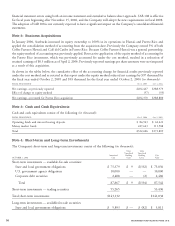Starbucks 2006 Annual Report Download - page 50
Download and view the complete annual report
Please find page 50 of the 2006 Starbucks annual report below. You can navigate through the pages in the report by either clicking on the pages listed below, or by using the keyword search tool below to find specific information within the annual report.
For scheduled rent escalation clauses during the lease terms or for rental payments commencing at a date other than the
date of initial occupancy, the Company records minimum rental expenses on a straight-line basis over the terms of the
leases on the consolidated statements of earnings.
Certain leases provide for contingent rents, which are determined as a percentage of gross sales in excess of specified levels.
The Company records a contingent rent liability in “Accrued occupancy costs” on the consolidated balance sheets and the
corresponding rent expense when specified levels have been achieved or when management determines that achieving the
specified levels during the fiscal year is probable.
Asset Retirement Obligations — Change in Accounting Principle
On October 1, 2006, Starbucks adopted FASB Interpretation No. 47 (“FIN 47”), “Accounting for Conditional Asset
Retirement Obligations — an interpretation of FASB Statement No. 143,” which requires the recognition of a liability
for the fair value of a legally required conditional asset retirement obligation when incurred, if the liability’s fair value can
be reasonably estimated. The Company’s asset retirement obligation (“ARO”) liabilities are primarily associated with the
disposal of leasehold improvements which, at the end of a lease, the Company may be contractually obligated to remove
in order to restore the facility back to a condition specified in the lease agreement. The Company estimates the fair value
of these liabilities based on current store closing costs, accretes that current cost forward to the date of estimated ARO
removal, and discounts the future cost back as if it were performed at the inception of the lease. At the inception of such a
lease, the Company records the ARO liability and also records a related capital asset in an amount equal to the estimated
fair value of the liability. The ARO liability is accreted to its future value, with the accretion expense recognized as
operating expense. The capitalized asset is depreciated on a straight-line basis over the useful life of the asset, which
generally mirrors the life of the leasehold improvement. Upon ARO removal, any difference between the actual
retirement costs incurred and the recorded estimated ARO liability is recognized as an operating gain or loss in the
consolidated statement of earnings. In future periods, the Company may make adjustments to the ARO liability as a
result of the availability of new information, changes in labor costs and other factors. The estimate of the ARO liability is
based on a number of assumptions requiring management’s judgment, including store closing costs, cost inflation rates
and discount rates.
The initial impact of adopting FIN 47 resulted in a charge of $27.1 million, with a related tax benefit of $9.9 million, for
a net expense of $17.2 million, or $0.02 per diluted share. The net amount was recorded as a cumulative effect of a change
in accounting principle on the consolidated statement of earnings. FIN 47 requires that the cumulative approach to
adoption be used rather than retrospectively revising prior year financial statements. The adoption increased “Property,
plant and equipment, net,” by $15.5 million, increased “Other long-term liabilities” for AROs by $34.2 million,
increased “Other assets” for deferred tax assets by $6.8 million, and decreased “Equity and other investments” by
$5.3 million. The following table presents, on a pro forma basis, what the ARO liability would have been had FIN 47
been in effect during fiscal 2005 and 2004. These pro forma amounts are estimated based upon the information,
assumptions and interest rates used to measure the ARO liability recognized upon adoption of FIN 47 as of October 1,
2006 (in millions):
Pro forma ARO liability, October 2, 2005 $29.2
Pro forma ARO liability, October 3, 2004 25.2
Pro forma ARO liability, September 28, 2003 20.9
Stock-based Compensation — Change in Accounting Principle
The Company maintains several equity incentive plans under which it may grant non-qualified stock options, incentive
stock options, restricted stock or stock appreciation rights to employees, non-employee directors and consultants. The
Company also has employee stock purchase plans (“ESPP”).
Prior to the October 3, 2005 adoption of the SFAS No. 123(R), “Share-Based Payment” (“SFAS 123R”), Starbucks
accounted for stock-based compensation using the intrinsic value method prescribed in Accounting Principles Board
46 STARBUCKS CORPORATION, FORM 10-K
























